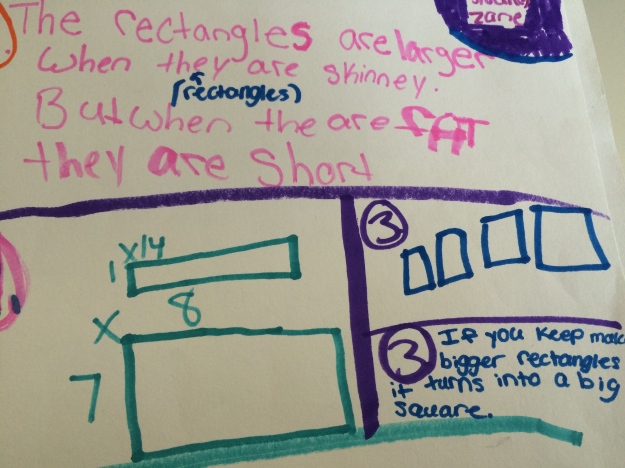Yesterday’s math lesson launched based on this student activity book page in Investigations…
Students read the introduction and I first asked them, “If we were to build these in Minecraft, was feet an appropriate unit of measure?” Some thought that feet seemed too small for a garden and instead wanted to use yards, that was, until one student schooled us all on Minecraft. Come to find out, Minecraft uses the metric system with each block representing one cubic meter. We then changed the unit to meters and were on our way.
I gave them 10 minutes, either with a partner or individually, to build as many different rectangular garden designs as they could with 30 meters of fencing. As I walked around, it was interesting to see how students were designing their gardens. Some started building random dimensions and adding/subtracting fence links to eventually hit 30 while others had thought of one rectangle to start and adjusted from there by subtracting/adding from sides. It was fun to see the ones that discovered a pattern in their building and sped through the rest of the rectangles. Some beautiful patterns emerged….
 After 10 minutes, I asked them fill in the table on their activity page and chat with their table to see if anyone had any dimensions they didn’t have. As a table, they came up with some noticings based on their table, Minecraft builds, and process of building.
After 10 minutes, I asked them fill in the table on their activity page and chat with their table to see if anyone had any dimensions they didn’t have. As a table, they came up with some noticings based on their table, Minecraft builds, and process of building.










 The class ended after this group work. Talking with another colleague about the lesson at the end of the day, we chatted about what claims could come out of this lesson. It was so interesting to me to think about not only the geometric claims, in terms of rectangles and dimensions, but also the numeric claims that can evolve from these conversations as well. And to think that these number claims are grounded in a visual connection is pretty awesome to me!
The class ended after this group work. Talking with another colleague about the lesson at the end of the day, we chatted about what claims could come out of this lesson. It was so interesting to me to think about not only the geometric claims, in terms of rectangles and dimensions, but also the numeric claims that can evolve from these conversations as well. And to think that these number claims are grounded in a visual connection is pretty awesome to me!
I was so I started today by pairing up every two tables to share with one another. One table read their noticings while the job of the other table was to ask clarifying questions. That gave me time to circulate, listen, and choose the claims for our class share out. After the table shares, we reconvened as a whole class and chatted about a few of the claims as a group.
 I asked them to think about similarities and if we could combine some of them to form one claim based on our work.
I asked them to think about similarities and if we could combine some of them to form one claim based on our work.
Class ended with a journal entry in which they worked independently to begin to form a claim or the beginnings of one. Here is where I will start tomorrow…
As a follow up on this post, this is the assessment on their work with perimeter and area. During the class period, only one student started working on finding the square that would give them the largest area with a perimeter of 30. After this idea came out in our class discussion, using fractional dimensions was something that others were thinking about during the assessment. Here is a student’s (different than the initial student) work that I thought was pretty fantastic:
-Kristin









Was only one student interested in calculating the largest area rectangle? I understand the pics are just a sample, but I’m curious to know how typical/rare that was.
Here’s a possible extension to your investigation:
We, adults, know that the largest area enclosed by a fixed perimeter boundary is a circle. If you have to build on a grid (like minecraft?), you can’t get a circle, but you can approximate one (with little jagged zig-zags). Will that be the largest area enclosed by a fixed perimeter boundary?
LikeLike
Pingback: Supporting Mathematical Habits of Mind | MathMinds